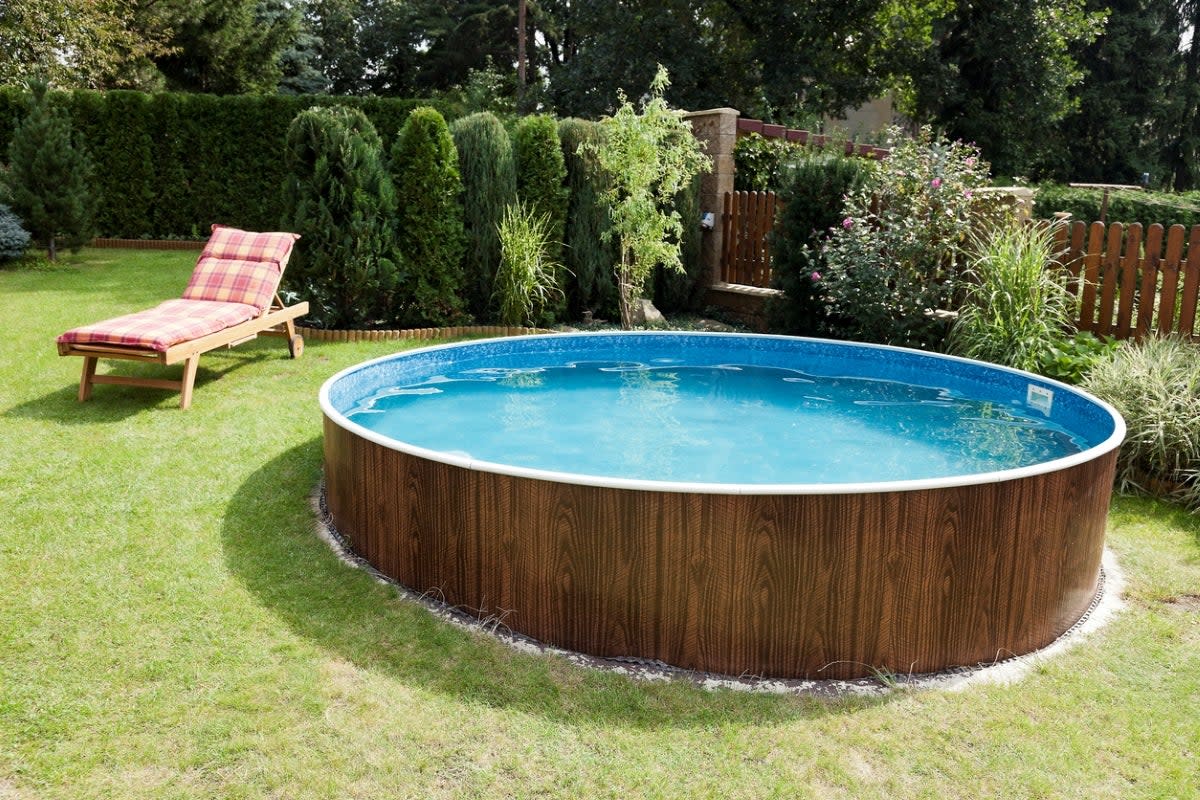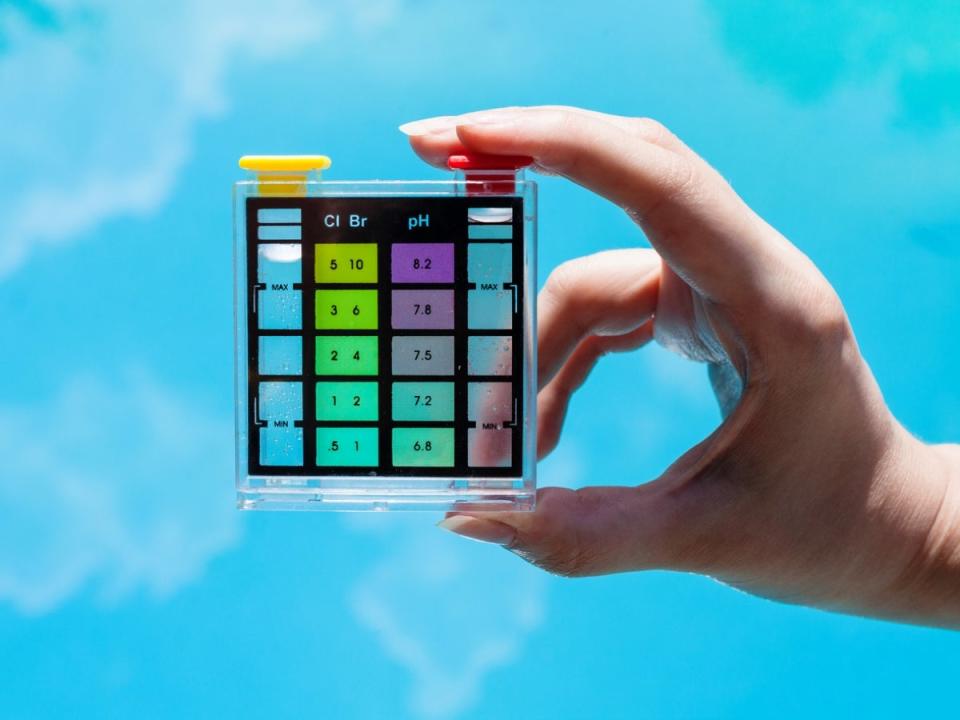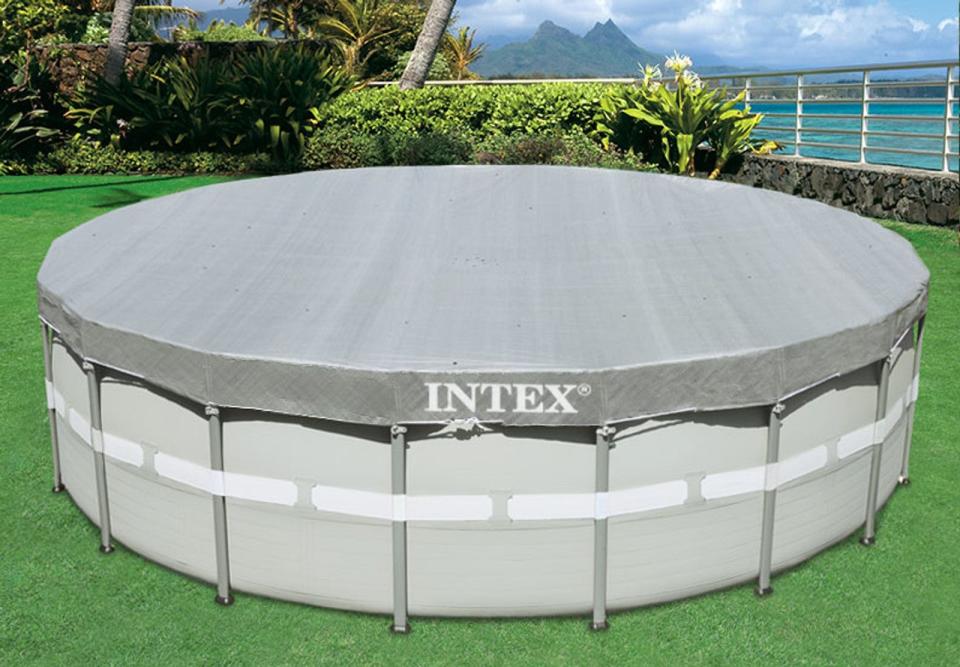7 Important Things to Know About Above-Ground Pool Maintenance

Whether you already have an above-ground pool in your backyard or are looking to set one up soon, it’s important to know how to clean above-ground pools first. Without proper maintenance and care, your pool could become dirty or even unsafe to swim in due to chemical imbalances.
While you could hire a local pool cleaning service and pay them to maintain your above-ground pool, maintaining and cleaning a swimming pool on your own is fairly straightforward. DIY pool care not only saves on pool maintenance costs, but you may also find that you enjoy spending time keeping your pool swim-ready. Read on to learn more about above-ground pool maintenance, including what you need to do to keep your pool clean, the water clear, and the chlorine and pH levels balanced.
RELATED: Planning Guide: Above-Ground Swimming Pools
1. Test the pool’s pH and chlorine levels, and skim the water, daily.
It’s essential to maintain the right balance of chlorine and pH levels in any kind of pool. Chlorine keeps pool water clean and eliminates bacteria, microorganisms, and algae. However, chlorine levels diminish over time with exposure to the sun, swimmers, and more. Testing your above-ground pool's chlorine levels daily with a pool test kit—such as this multi-purpose HTH test kit—can help you keep the chlorine level between the recommended 2.0 and 4.0 parts per million (ppm). When needed, add liquid chlorine or chlorine tablets, with Clorox Pool & Spa Chlorinating Tablets coming highly recommended in our guide to the best chlorine tablets.
In addition to testing the chlorine level, it is also important to check the pool’s pH level daily. The pH level should be between 7.4 and 7.6. With a balanced pH, you can avoid cloudy pool water or water that irritates swimmers’ eyes. Keeping the pH between 7.4 and 7.6 also helps prevent the pool’s pump, ladders, and other surfaces from corroding. If needed, you can add some baking soda to increase the pH level of the water.
After testing and adjusting your pool’s pH and chlorine levels, you should also use a skimmer net to remove bugs and other debris from the surface. Our researched guide to the best pool skimmers has plenty of terrific choices.

Photo: istockphoto.com
2. Shock your above-ground pool weekly.
Shocking an above-ground pool on a weekly basis is another important aspect of pool maintenance. Pool shock treatments like HTH Super Shock Treatment, the favorite in our guide to the best pool shock, help remove contaminants like bacteria and algae from the water. This powdered form of chlorine increases the water’s level of “free chlorine.” Shocking the pool can be especially beneficial if several people recently swam in it or following a rainstorm.
You should shock your pool in the evening. Otherwise, midday sunlight can break down the chlorine before it’s fully able to do its job. After adding shock to the pool, turn the pump on and let it run for 8 or more hours. Avoid swimming in the pool until the following day.
3. Run the pump for at least 8 hours a day to maintain the water circulation.
Running the pump daily is an important part of above-ground pool maintenance. The pump has the important job of circulating the pool’s water, which is one reason why you want to choose the best pool pump possible, such as the Hayward MaxFlo XL Pool Pump.
When the water in your pool moves around, it helps keep the pool clean. More dirt and debris will find their way into the skimmer baskets, and algae growth will become less likely. Because pumps may not circulate your water perfectly, use a pool brush or another long pool supply to agitate the water in spots with poor flow.
While you don’t need to leave your pool’s pump running constantly, running it for at least 8 hours each day is a good rule of thumb to follow. However, some manufacturers may have different recommendations, so it's always a good idea to consult your pump’s user’s manual.
RELATED: Buyer's Guide: The Best Above-Ground Pool Steps

Photo: istockphoto.com
4. Clean and replace your pool filter regularly.
Whether you have a cartridge, sand, or diatomaceous earth (DE) filter for your above-ground pool, make sure to clean it regularly. The pool filter is responsible for removing particles from the water, leaving it clean and safe for swimming. Without proper cleaning, the water in the pool may become polluted. It is also possible for the filter to become clogged, leading to a larger problem.
Check the manufacturer’s recommendations and clean your filter regularly. Cartridge filters should be removed and cleaned with a water hose about once a week, and they need to be replaced every 1 to 2 years. Sand and DE filters should be backwashed about once per month and replaced or refilled every 3 to 5 years.
If you need an above-ground pool filter, consider the Intex Krystal Clear Sand Filter Pump, the top pick in our guide to the best above-ground pool filters.
5. Clean out the pump and pool skimmer baskets every day.
When thinking about how to maintain a pool, don’t forget to empty the skimmer and pump baskets daily. The skimmers pull leaves and other smaller debris floating on the water surface. These debris are then held in the skimmer basket, stopping them from finding their way to the pump or filter. Emptying these baskets as part of your above-ground pool cleaning routine will keep your pool cleaner and help prevent clogs.
In addition to emptying skimmer baskets, you should also check and empty your above-ground pool's pump basket every day. This basket holds debris that made it past the skimmer baskets or were pulled in through the pool’s drains. Emptying this basket daily can keep the debris from getting into the pump itself and clogging the impeller and reducing the amount of water that is flowing through the system. Before emptying the basket, remember to turn off the pump.
RELATED: Buyer's Guide: The Best Above-Ground Pool Vacuum

Photo: amazon.com
6. Learn how to winterize an above-ground pool properly.
If you live in an area where pools must be winterized, doing so properly will ensure it’s in a safe and usable shape next year. While you could pay to have a local maintenance service winterize your pool, you can also do it yourself to save money.
To winterize the pool, start by performing a thorough cleaning. It’s actually best to leave above-ground pools filled with water for the winter, rather than draining them. After cleaning the pool, ensure the chlorine and pH levels are balanced and add in winterizing chemicals, such as In the Swim's Pool Closing Kit.
Then, remove and safely store the pump, filter, skimmer, pool lines, ladders, and any other accessories and supplies. Finally, cover the pool using an air pillow and pool cover. The air pillow will hold up the cover, preventing it from freezing with the water in the pool.
RELATED: Buyer's Guide: The Best Robotic Pool Cleaners We Tested This Year
7. Install a sump pump to protect your house from leaks.
While not directly related to how to maintain a pool, it’s also a good idea to install a sump pump in your house if you have an above-ground pool. If the pool leaks or drains towards your home, it could potentially flood and damage your basement. Wet basements are susceptible to mold and mildew growth, which can cause breathing difficulties for the people in the home. A sump pump works to pump water away from the home, keeping your foundation and basement dry in the presence of water.
